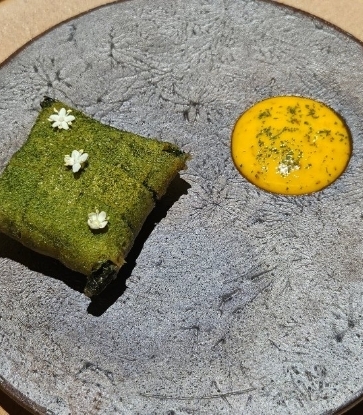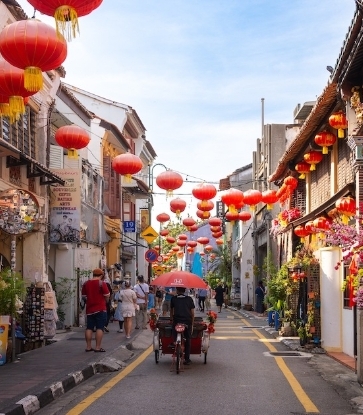70-year-old Madam Gaik Lean Beh, or fondly known as Auntie Gaik Lean, is the larger-than-life persona who runs her eponymously named MICHELIN-Starred Nyonya restaurant, Auntie Gaik Lean’s Old School Eatery, with an iron fist in a velvet glove.
Always immaculately turned out and poised, Beh quips, almost imperiously, “To be neat, tidy, and properly dressed at all times simply reflect our Nyonya upbringing.” Showing us her calloused hands, she says, “I learnt to cook the hard way. When I was working for Dato’ Lim Bian Yam, I started as a dishwasher. No shortcuts.”

The late Dato' Lim Bian Yam (1933-2017) was one of Penang’s Living Heritage Treasures, as recognised by the Penang Heritage Trust, for his expertise in Nyonya cooking. Through the years they were together, Beh rose to become his right-hand woman and his indispensable assistant in the kitchen.
One of Beh's most cherished memories was running the staff cafeteria for Motorola, a large American multinational semiconductor company in Penang in the 1970s, where the management showed their appreciation by sponsoring her for various F&B training programs. “I received my formal culinary training when I was working with Motorola — those were the best years of my life,” she reminisces.
Prior to her current position, Beh had moved to Kuala Lumpur to head the kitchens of a Nyonya restaurant there for six years — until her son, Adrian Tan, missing his mother’s cooking, and recognising the vast potential of her much-vaunted talent back in Penang — opened a restaurant named after her to entice her home.

Thus, Auntie Gaik Lean’s Old School Eatery was born in 2013. Strategically located in the heart of Penang’s financial district, it began attracting bankers, lawyers, and the city’s movers and shakers. Soon, it became the go-to Nyonya eatery for visiting Malaysian sultans and members of royalty.
“We never laid off a single staff during the terrible COVID lockdown. We even sold one of our houses so we could continue paying our staff, as the restaurant had to stay closed for months,” Beh shares.
Her tenacity has been rewarded by having a brigade of loyal, highly disciplined staff, functioning with clockwork efficiency in her bright, pristine-clean kitchen, which has once been described by an observer as being “well-run like an orchestra”.
“I judge how good a Nyonya cook is by how well she prepares two dishes: tau eu bak and its accompanying sambal,” Beh quips. Tau eu bak is soy-braised pork belly, a classic Penang-Nyonya dish, usually eaten with a spicy sambal concocted from pounded chilis, toasted belacan (fermented shrimp paste), and a squeeze of calamansi lime.

But one won’t find tau eu bak on the menu of Auntie Gaik Lean’s Old School Eatery, though. The reason being that Beh runs a non-pork kitchen, and she procures all her raw produce and ingredients from halal-certified suppliers. “My daughter is a Muslim convert — my son-in-law is Malay. I want them and my grandchildren to be able to come and eat at my restaurant — our family restaurant — any time they want," says Beh with a smile.
Asking her to name her specialty dishes, Beh lists down jiew hu char (stewed shredded jicama with dried cuttlefish), chicken curry Kapitan, and nasi ulam. “People asked me if I ever get tired from all this cooking as I am 70 years old now. I tell them, no, because I love cooking — it is my lifelong passion!”

Nasi ulam, the resplendent, colourful Nyonya rice salad, is must-have when one is in Penang. Watching Beh assemble her nasi ulam was mesmerising: her quick, sure hands dive into the cornucopia of finely-shredded herbs, edible leaves, and flowers arrayed before her. She strews these over the rice, like a floral bouquet cascading from an Asian horn of plenty. Toasted shredded coconut lends a rich, nutty flavour, whilst the dried shrimps and salted fish provide the savoury umami hit. Her deft fingers coax all the ingredients into a veritable edible work of art.

Auntie Gaik Lean’s Recipe for Nasi Ulam
Ingredients
- ½ thumb-sized fresh turmeric
- 2 cups cooked rice (warm)
- 20g salted fish
- 60g dried shrimps
- 60g grated coconut
- 1 cup fresh shallots
- 1 stalk lemongrass (serai)
- 1 turmeric leaf (daun kunyit)
- 10-15 wild betel leaves (daun kaduk)
- 4-8 sand ginger leaves (daun cekur)
- 3-6 stalks Vietnamese coriander leaves (daun kesum)
- 3-6 stalks mint leaves
- 4-8 kaffir lime leaves (daun limau perut)
- Pepper, salt & sugar to taste
Method
Preparation:
- Use the turmeric leaf to roll daun kaduk, daun cekur, daun kesum, daun limau perut, and mint leaves. Slice as finely as possible. Set aside.
- Finely slice the fresh shallots.
- Finely chop the lemongrass.
- Finely chop the turmeric.
- Fry salted fish in a bit of oil till dry and crisp.
- Dry-fry dried shrimps till crisp.
- Pound the salted dish and dried shrimps into a fine powder. Set aside.
- Dry-fry the grated coconut till light brown and toasted. This is called the kerisek.
- To the warm rice, gradually add in small amounts the following:
a. The finely-chopped lemongrass.
b. The mix of finely-sliced turmeric leaf, daun kaduk, daun cekur, daun kesum, daun limau perut, and mint leaves.
c. The shallots, and salted fish/dried shrimp powder.
d. Add the dry-fried kerisek. - Lastly, add the fresh turmeric, and the toasted coconut (kerisek).
- Add white pepper, salt & sugar to taste.
Note: You do not have to use the whole amounts of the ingredients provided. Instead, taste and adjust the amounts accordingly to your preference. The Nyonyas call this “agak-agak” or “approximate the amount”.
Serve with sambal belacan and a squeeze of calamansi lime.
Auntie Gaik Lean's Old School Eatery is located at 1 Lebuh Bishop, George Town, 10200, Malaysia.
All photos are by Peter Yeoh.




















